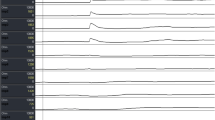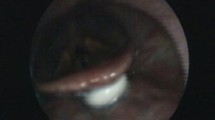Abstract
The purpose of this study was to determine if individuals with Parkinson’s disease (PD) demonstrate abnormal respiratory events when swallowing thin liquids. In addition, this study sought to define associations between respiratory events, swallowing apnea duration, and penetration–aspiration (P–A) scale scores. Thirty-nine individuals with PD were administered ten trials of a 5-ml thin liquid bolus. P–A scale score quantified the presence of penetration and aspiration during the swallowing of a 3-oz sequential bolus. Participants were divided into two groups based on swallowing safety judged during the 3-oz sequential swallowing: Group 1 = P–A ≤ 2; Group 2 = P–A ≥ 3. Swallows were examined using videofluoroscopy coupled with a nasal cannula to record respiratory signals during the event(s). Findings indicated that expiration was the predominant respiratory event before and after swallowing apnea. The data revealed no differences in our cohort versus the percentages of post-swallowing events reported in the literature for healthy adults. In addition, individuals with decreased swallowing safety, as measured by the P–A scale, were more likely to inspire after swallows and to have shorter swallowing apnea duration. Individuals who inspired before swallow also had longer swallowing apnea duration. The occurrence of inspiratory events after a swallow and the occurrence of shorter swallowing apnea durations may serve as important indicators during clinical swallowing assessments in patients at risk for penetration or aspiration with PD.
Similar content being viewed by others
References
Nishino T, Hiraga K. Coordination of swallowing and respiration in unconscious subjects. J Appl Physiol. 1991;70:988–93.
Zald DH, Pardo JV. The functional neuroanatomy of voluntary swallowing. Ann Neurol. 1999;46:281–6.
Broussard DL, Altschuler SM. Central integration of swallow and airway-protective reflexes. Am J Med. 2000;108(Suppl 4a):62S–7S.
Saito Y, Ezure K, Tanaka I. Swallowing-related activities of respiratory and non-respiratory neurons in the nucleus of solitary tract in the rat. J Physiol. 2002;540:1047–60.
Hiss SG, Strauss M, Treole K, Stuart A, Boutilier S. Swallowing apnea as a function of airway closure. Dysphagia. 2003;18:293–300.
Martin-Harris B, Brodsky MB, Price CC, Michel Y, Walters B. Temporal coordination of pharyngeal and laryngeal dynamics with breathing during swallowing: single liquid swallows. J Appl Physiol. 2003;94:1735–43.
Martin-Harris B, Brodsky MB, Michel Y, Ford CL, Walters B, Heffner J. Breathing and swallowing dynamics across the adult lifespan. Arch Otolaryngol Head Neck Surg. 2005;131:762–70.
Hirst LJ, Ford GA, Gibson GJ, Wilson JA. Swallow-induced alterations in breathing in normal older people. Dysphagia. 2002;17:152–61.
Klahn MS, Perlman AL. Temporal and durational patterns associating respiration and swallowing. Dysphagia. 1999;14:131–8.
Preiksaitis HG, Mayrand S, Robins K, Diamant NE. Coordination of respiration and swallowing: effect of bolus volume in normal adults. Am J Physiol. 1992;263:R624–30.
Preiksaitis HG, Mills CA. Coordination of breathing and swallowing: effects of bolus consistency and presentation in normal adults. J Appl Physiol. 1996;81:1707–14.
Martin BJ, Logemann JA, Shaker R, Dodds WJ. Coordination between respiration and swallowing: respiratory phase relationships and temporal integration. J Appl Physiol. 1994;76:714–23.
Smith J, Wolkove N, Colacone A, Kreisman H. Coordination of eating, drinking and breathing in adults. Chest. 1989;96:578–82.
Dozier TS, Brodsky MB, Michel Y, Walters BC Jr, Martin-Harris B. Coordination of swallowing and respiration in normal sequential cup swallows. Laryngoscope. 2006;116:1489–93.
Weiner P, Inzelberg R, Davidovich A, Nisipeanu P, Magadle R, Berar-Yanay N, Carasso RL. Respiratory muscle performance and the perception of dyspnea in Parkinson’s disease. Can J Neurol Sci. 2002;29:68–72.
Izquierdo-Alonso JL, Jimenez-Jimenez FJ, Cabrera-Valdivia F, Mansilla-Lesmes M. Airway dysfunction in patients with Parkinson’s disease. Lung. 1994;172:47–55.
Sabate M, Rodriguez M, Mendez E, Enriquez E, Gonzalez I. Obstructive and restrictive pulmonary dysfunction increases disability in Parkinson disease. Arch Phys Med Rehabil. 1996;77:29–34.
Vercueil L, Linard JP, Wuyam B, Pollak P, Benchetrit G. Breathing pattern in patients with Parkinson’s disease. Respir Physiol. 1999;118:163–72.
Polatli M, Akyol A, Cildag O, Bayulkem K. Pulmonary function tests in Parkinson’s disease. Eur J Neurol. 2001;8:341–5.
Pal PK, Sathyaprabha TN, Tuhina P, Thennarasu K. Pattern of subclinical pulmonary dysfunctions in Parkinson’s disease and the effect of levodopa. Mov Disord. 2007;22:420–4.
Troche MS, Sapienza CM, Rosenbek JC. Effects of bolus consistency on timing and safety of swallow in patients with Parkinson’s disease. Dysphagia. 2008;23:26–32.
Pinnington LL, Muhiddin KA, Ellis RE, Playford ED. Non-invasive assessment of swallowing and respiration in Parkinson’s disease. J Neurol. 2000;247:773–7.
Gross RD, Atwood CW Jr, Ross SB, Eichhorn KA, Olszewski JW, Doyle PJ. The coordination of breathing and swallowing in Parkinson’s disease. Dysphagia. 2008;23:136–45.
Pinnington LL, Muhiddin KA, Lobeck M, Pearce VR. Interrater and intrarrater reliability of the Exeter dysphagia assessment technique applied to healthy elderly adults. Dysphagia. 2000;15:6–9.
Selley WG, Ellis RE, Flack FC, Bayliss CR, Pearce VR. The synchronization of respiration and swallow sounds with videofluoroscopy during swallowing. Dysphagia. 1994;9:162–7.
Selley WG, Flack FC, Ellis RE, Brooks WA. The Exeter Dysphagia Assessment Technique. Dysphagia. 1990;4:227–35.
Kelly BN, Huckabee ML, Jones RD, Carroll GJ. The influence of volition on breathing-swallowing coordination in healthy adults. Behav Neurosci. 2007;121:1174–9.
Martin-Harris B, Logemann JA, McMahon S, Schleicher M, Sandidge J. Clinical utility of the modified barium swallow. Dysphagia. 2000;15:136–41.
Mendell DA, Logemann JA. Temporal sequence of swallow events during the oropharyngeal swallow. J Speech Lang Hear Res. 2007;50:1256–71.
Logemann JA, Rademaker AW, Pauloski BR, Ohmae Y, Kahrilas PJ. Normal swallowing physiology as viewed by videofluoroscopy and videoendoscopy. Folia Phoniatr Logop. 1998;50:311–9.
Dodds WJ, Stewart ET, Logemann JA. Physiology and radiology of the normal oral and pharyngeal phases of swallowing. AJR Am J Roentgenol. 1990;154:953–63.
Dantas RO, Kern MK, Massey BT, Dodds WJ, Kahrilas PJ, Brasseur JG, Cook IJ, Lang IM. Effect of swallowed bolus variables on oral and pharyngeal phases of swallowing. Am J Physiol. 1990;258:G675–81.
Martin-Harris B, Michel Y, Castell DO. Physiologic model of oropharyngeal swallowing revisited. Otolaryngol Head Neck Surg. 2005;133:234–40.
Gross RD, Atwood CW Jr, Grayhack JP, Shaiman S. Lung volume effects on pharyngeal swallowing physiology. J Appl Physiol. 2003;95:2211–7.
McCool FD. Global physiology and pathophysiology of cough: ACCP evidence-based clinical practice guidelines. Chest. 2006;129:48S–53S.
Smith Hammond C. Cough and aspiration of food and liquids due to oral pharyngeal dysphagia. Lung. 2008;186(Suppl 1):S35–40.
Smith Hammond CA, Goldstein LB, Zajac DJ, Gray L, Davenport PW, Bolser DC. Assessment of aspiration risk in stroke patients with quantification of voluntary cough. Neurology. 2001;56:502–6.
Martin-Harris B, Brodsky MB, Michel Y, Lee FS, Walters B. Delayed initiation of the pharyngeal swallow: normal variability in adult swallows. J Speech Lang Hear Res. 2007;50:585–94.
Potulska A, Friedman A, Krolicki L, Spychala A. Swallowing disorders in Parkinson’s disease. Parkinsonism Relat Disord. 2003;9:349–53.
Ali GN, Wallace KL, Schwartz R, DeCarle DJ, Zagami AS, Cook IJ. Mechanisms of oral-pharyngeal dysphagia in patients with Parkinson’s disease. Gastroenterology. 1996;110:383–92.
Fuh JL, Lee RC, Wang SJ, Lin CH, Wang PN, Chiang JH, Liu HC. Swallowing difficulty in Parkinson’s disease. Clin Neurol Neurosurg. 1997;99:106–12.
Nagaya M, Kachi T, Yamada T, Igata A. Videofluorographic study of swallowing in Parkinson’s disease. Dysphagia. 1998;13:95–100.
Monte FS, da Silva-Junior FP, Braga-Neto P, Nobre e Souza MA, Sales de Bruin VM. Swallowing abnormalities and dyskinesia in Parkinson’s disease. Mov Disord. 2005;20:457–62.
Hunter PC, Crameri J, Austin S, Woodward MC, Hughes AJ. Response of parkinsonian swallowing dysfunction to dopaminergic stimulation. J Neurol Neurosurg Psychiatry. 1997;63:579–83.
Robbins JA, Logemann JA, Kirshner HS. Swallowing and speech production in Parkinson’s disease. Ann Neurol. 1986;19:283–7.
Fernandez HH, Lapane KL. Predictors of mortality among nursing home residents with a diagnosis of Parkinson’s disease. Med Sci Monit. 2002;8:CR241–6.
Bird MR, Woodward MC, Gibson EM, Phyland DJ, Fonda D. Asymptomatic swallowing disorders in elderly patients with Parkinson’s disease: a description of findings on clinical examination and videofluoroscopy in sixteen patients. Age Ageing. 1994;23:251–4.
Hughes AJ, Daniel SE, Kilford L, Lees AJ. Accuracy of clinical diagnosis of idiopathic Parkinson’s disease: a clinico-pathological study of 100 cases. J Neurol Neurosurg Psychiatry. 1992;55:181–4.
Hoehn MM, Yahr MD. Parkinsonism: onset, progression, and mortality. Neurology. 1967;17:427–42.
Folstein MF, Folstein SE, McHugh PR. “Mini-mental state”. A practical method for grading the cognitive state of patients for the clinician. J Psychiatr Res. 1975;12:189–98.
Robbins JM, Coyle J, Rosenbek J, Roecker E, Wood J. Differentiation of normal and abnormal airway protection during swallowing using the penetration-aspiration scale. Dysphagia. 1999;14(4):228–32.
Rosenbek JC, Robbins JA, Roecker EB, Coyle JL, Wood JL. A penetration-aspiration scale. Dysphagia. 1996;11:93–8.
Morton R, Minford J, Ellis R, Pinnington L. Aspiration with dysphagia: the interaction between oropharyngeal and respiratory impairments. Dysphagia. 2002;17:192–6.
Butler SG, Stuart A, Pressman H, Poage G, Roche WJ. Preliminary investigation of swallowing apnea duration and swallow/respiratory phase relationships in individuals with cerebral vascular accident. Dysphagia. 2007;22(3):215–24.
Acknowledgments
This work was supported by VA Merit Grant RR & D B3721R to Christine Sapienza, PhD.
Author information
Authors and Affiliations
Corresponding author
Rights and permissions
About this article
Cite this article
Troche, M.S., Huebner, I., Rosenbek, J.C. et al. Respiratory-Swallowing Coordination and Swallowing Safety in Patients with Parkinson’s Disease. Dysphagia 26, 218–224 (2011). https://doi.org/10.1007/s00455-010-9289-x
Received:
Accepted:
Published:
Issue Date:
DOI: https://doi.org/10.1007/s00455-010-9289-x




